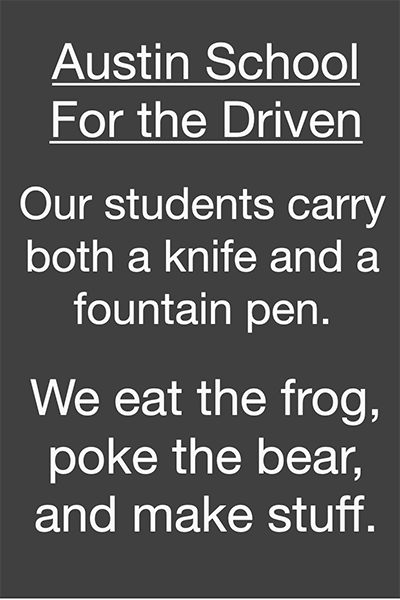Conversations about schooling: The Smart Schooling Book Group
/Alt Ed Austin is pleased to help spread the word about a new book group focused on crucial questions about educational systems and new understandings in the psychology of learning. Antonio Buehler, founder of Abrome, joins us on the blog to explain why he started the group and how you can join the conversations.
The majority of the parents we talk to are not eagerly looking to provide their children with a rich, self-directed learning environment. Sadly, most of the parents we talk to are trying to save their children from the trauma that is so often associated with schooling (e.g., testing, sleep deprivation, depression, bullying). One of the greatest challenges we face when talking to those parents about Emancipated Learning as an alternative to school is that it is often the first time that they have heard of an educational environment that does not rely on coercion. Most of them have never been introduced to the notion of self-directed education, or they believe that self-directed education can be achieved by allowing a student to pick a topic they are expected to write a report about. They might have heard of homeschooling, but have never heard of unschooling, Sudbury Valley, or Summerhill.
Instead of being able to highlight how we are creating a psychologically safe learning space where young people can engage in deep, meaningful, and enduring learning experiences that will allow them to lead remarkable lives, we are left trying to educate them on human psychology, the history of schooling, and the science of learning. Needless to say, a 30-minute conversation covering such deep topics is typically not enough to compel parents to take meaningful action to improve their children’s learning experiences in their current schools, to move them to alternative schools that better meet their children’s needs, or to opt out of schooling altogether.
At the same time, there are a lot of teachers and administrators who know that something is not working at their schools but do not know what they can do to substantially improve the situation. They have most likely never been introduced to much of the research that proves that self-directed learning is the best way to deepen learning, promote lifelong learning, and eliminate much of the trauma associated with coercive schooling. It is not their fault, as the organizations they work for and the education schools that they attended go out of their way to ignore these topics, and instead focus on marginal reforms while pushing the baseline assumption that young people need to be forced to learn, and that schooling environments are where that happens.
In an attempt to spur the necessary conversations around education that are currently not happening, we will be hosting the “Smart Schooling Book Group” at the Laura Bush Community Library for the duration of this year. We will read one book each month that focuses on education, with an emphasis on the psychology that would ideally inform how we approach education, and then come together to discuss it on the last Thursday of each month.
2017 Reading List
Jan 26: Why Don't Students Like School? by Daniel Willingham
Feb 23: The Price of Privilege by Madeline Levine
Mar 30: Wounded by School by Kirsten Olsen
Apr 27: Free to Learn by Peter Gray
May 25: Overschooled but Undereducated by John Abbott
Jun 29: Ungifted: Intelligence Redefined by Scott Barry Kaufman
Jul 27: Gardener and the Carpenter by Alison Gopnik
Aug 31: Drive by Daniel Pink
Sep 28: Summerhill School: A New View of Childhood by A. S. Neill
Oct 26: The End of Average by Todd Rose
Nov 30: Old School by Tobias Wolff (novel)
Dec 28: Mindset by Carol Dweck
We hope that young people, parents, future parents, teachers, and school administrators can all benefit from these readings and conversations. Hopefully, some school board members will also drop in.
Antonio Buehler









![Photo by Larry D. Moore [CC BY-SA 3.0 or GFDL], via Wikimedia Commons](https://images.squarespace-cdn.com/content/v1/54d27ffde4b0efe7320caf64/1470091440345-L80367KNGLS0M0I7BM1I/image-asset.jpeg)








